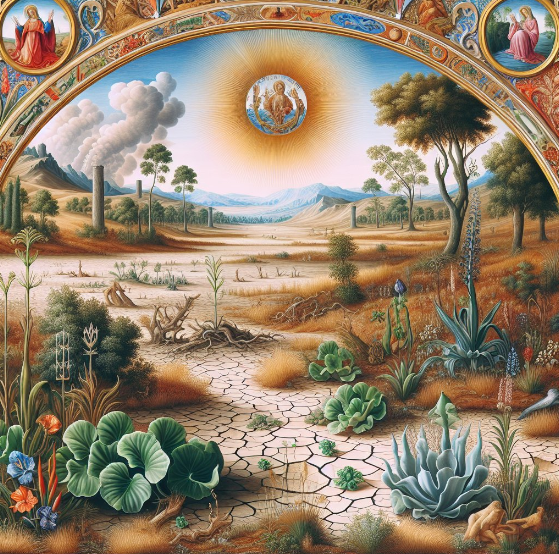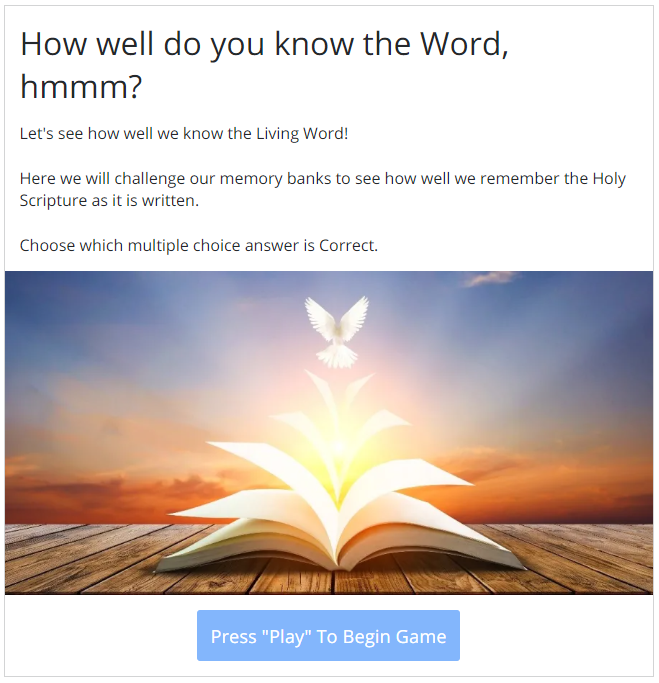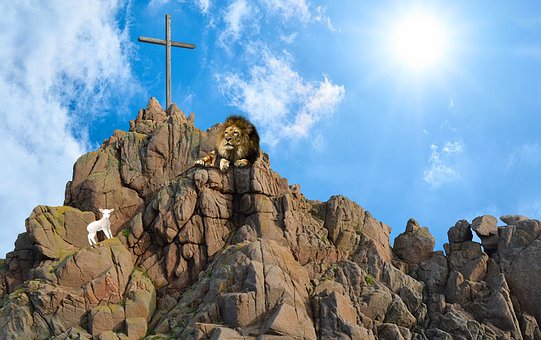The world was to be rendered Consisting or formed of land and water, and this was effected by a volcanic convulsion on its surface, the upheaving of some parts, the sinking of others, and the formation of vast hollows, into which the waters quickly rushed, as is graphically described (Psalm 104:6-9).
Thus a large part of the earth was left “dry land,” and thus were formed oceans, seas, lakes, and rivers which, though each having its own bed, or channel, are all connected with the sea.
Genesis 1:9-13 KJV
[9] And God said, Let the waters under the heaven be gathered together unto one place, and let the dry land appear: and it was so.
[10] And God called the dry land Earth; and the gathering together of the waters called he Seas: and God saw that it was good.
[11] And God said, Let the earth bring forth grass, the herb yielding seed, and the fruit tree yielding fruit after his kind, whose seed is in itself, upon the earth: and it was so.
[12] And the earth brought forth grass, and herb yielding seed after his kind, and the tree yielding fruit, whose seed was in itself, after his kind: and God saw that it was good.
[13] And the evening and the morning were the third day.
Genesis 1:9
And God said, Let the waters under the heaven be gathered together unto one place, and let the dry land appear: and it was so.
The gathering of the waters . . . unto one place refers to the seas on the surface of the earth. The result is that land-forms appear. Again, the account does not say how, or how quickly, God does this. It simply happens at His command.
Now there is a horizontal division made of the waters.
First the waters above were separated from the waters beneath. Now the water is separated from the land, from the earth.
May I say to you, there is nothing unscientific about this. They tell us that every spot on topside of this earth on which we live today was covered with water at one time.
That was evidently a judgment that had come upon the earth way back sometime in the distant eternity of the past, and we know practically nothing about it.
Anything we say is speculation. God has really told us very little here. But He has told us enough so that we can believe Him, that’s all.
Verse 9 begins the third day of God’s creation week. On this day, God continues to refine His creation by adding more detail and order to the earth. On day one, God created light and separated day from night.
On day two, He created a “firmament” which we would think of as the sky. These follow the rigid structure of Genesis chapter 1: God speaks, creates, observes, declares His creation “good,” and then numbers the day.
Each of the first three days prepares for something God will create on a corresponding day in the second half of this creation week.
Here, in verse 9, God separates land from ocean. More specifically, He commands the waters of the earth to be gathered into “one place,” and that the dry land appear.
This doesn’t necessarily mean that God created one single ocean, as we would understand it. However, looking at the earth as seen today, all of the “oceans” are connected into one single, massive, continuous body of water.
In the next verse, these waters are called “seas.” The word picture presented here is a global body of water punctuated by one or more land masses.
Once again, the emphasis is not on minute details, but a “big picture.” The point of this verse, as with the rest of Genesis chapter one, is crediting God—and God alone—with the power and authority to create all we see.
As with verse 7, God’s ability to create is understated, using the Hebrew phrase wa yehi kēn: “and it was so.” For God, this act of creation is no more or less complex than this: He commands, and it is so.
We stand in awe at the power being described here. With a sentence, God brings dry, habitable land to the earth, ready to support the abundance of life that He is about to create.
Genesis 1:10
And God called the dry land Earth; and the gathering together of the waters called He Seas: and God saw that it was good.
One of the deities of the ancient world was Yam, a name equivalent to the Hebrew word for seas. The verse before us stands in sharp contrast with such a myth as it credits the one, true God as Creator of the seas.
The seas are simply inanimate water, neither sentient nor divine.
“God called the dry land Earth.” What is He getting ready to do?
Well, it looks like He is getting ready to make a place where He can put man, a place that is habitable.
Man is not a water creature, even though there are evolutionists who think we came from the sea and from seaweed, as we mentioned, and others who think we came out of a slop bucket!
How absurd can they possibly be?
This account of day 3 of creation follows the pattern of the previous two days. God speaks something into existence, names it, and then observes that it is good. This is then followed by a numbering of the day.
According to Hebrew thinking, the act of naming something implies the namer’s responsibility for and rule over that thing. To name something is to have power over it. In this case, God names the dry ground “land” or “Earth,” and He names the waters “seas.”
Once again, God recognizes what He has made as good. That is a significant statement, coming from the ultimate standard of everything, which is God Himself.
As we get to know Him in the Bible, we see that He measures goodness in absolutes. To be good, in this sense, means that there is no “bad” in a thing. All that God made during His creation week was utterly and truly good.
Genesis 1:11
And God said, Let the earth bring forth grass, the herb yielding seed, and the fruit tree yielding fruit after his kind, whose seed is in itself, upon the earth: and it was so.
Various kinds of plant life appear. This continues the preparation of the earth for human habitation, for now there is renewable sustenance of the earth necessary for survival of humans and animals.
Now God is putting plant life here because man, until the Flood, was a vegetarian. Man will eat nothing but fruit and nuts.
The bare soil was clothed with lush green vegetation, and it is noticeable that the trees, plants, and grasses – the three great divisions of the vegetable kingdom here mentioned – were not called into existence in the same way as the light and the air.
They were made to grow, and they grew as they do still out of the ground – not, however, by the slow process of vegetation, but through the divine power, without rain, dew, or any process of labor – sprouting up and flourishing in a single day.
The forming of the plant life completed the third day. The third day of God’s creation week involves some extraordinary developments.
First, as described in the previous verses, God spoke and caused dry land to appear, separating it from the seas. This follows the pattern of Genesis 1: speaking, creation, naming, blessing, and numbering.
In this verse, God once again speaks, commanding vegetation to grow on this newly formed land.
The wording of the verse is specific, though various translations handle it slightly differently. In general, the Hebrew phrasing around “seeds” and “kinds” implies a particular intent within creation.
We are meant to understand that these plants and trees produced in themselves their own seeds. Built into them was the ability to reproduce, according to their own kind.
In other words, God’s decree was that each kind of plant and tree would bear the seed of the next generation of that specific kind of plant and tree.
This once again places a claim to God’s supremacy over all aspects of creation, including the form and function of all living things.
Genesis 1:12
And the earth brought forth grass, and herb yielding seed after his kind, and the tree yielding fruit, whose seed was in itself, after his kind: and God saw that it was good.
The phrase after his kind is important and remarkable in indicating that watermelon seeds result in watermelons, etc. If we pause to consider the consistency of this, it is remarkable yet today.
This verse nearly repeats the language of the previous verse. God commanded something to happen on earth: the development of plants and trees. This verse describes this very thing happening, exactly as God declared it.
Plants and trees of many kinds came into being, and each of them carried the seed that would cause the next generation of those specific plants and trees to grow on their own.
Another key fact to take from this account is that God built reproduction into His creation from the very start. His intent is clear: He would not create the world over and over again. He would create it all once.
He would make it good, and He would build into His good creation the ability to keep recreating itself according the kind—of plant, in this case—which it was.
Genesis 1 provokes various debates and conversations about how and when God created, and how or if that creation has changed since the initial creation.
What is clear is that the Bible intends us to understand that God, and God alone, made living things with the intent of them reproducing, from the very beginning.
Genesis 1:13
And God saw that it was good. And the evening and the morning were the third day.
The account of the third day concludes with a refrain found throughout the first chapter of Genesis: God approves of what He has created. This simple verse repeats the pattern for numbering each day of God’s creation week.
As mentioned previously, the Israelites counted days from sunset to sunset, from evening through morning and on into the daylight hours. That may be why each day is described in this way.
This completes the pattern of Genesis chapter 1, for the first half of the creation “week.” In each case, God speaks, then His words are fulfilled, then He names His creation, and then declares it good.
The Bible then applies a number to that creative day. Each of the first three days produced the conditions needed to support what God will create in each of the second three days.
The first half of these days produced light, the sky and seas, and then land. The second half, then, will see God populate those areas with the sun and moon, birds and sea creatures, and land creatures, respectively.
The lack of detail in these verses is probably deliberate. The point of Genesis chapter 1 is to deliver a powerful truth: that God, and God alone, is responsible for the creation we see around us.
And, that those created things have no power. Sun, sea, trees, and sky are not gods or spirits, but objects formed by God.
We may not have complete understanding of how God accomplished His creation, but the Bible leaves no room for doubt as to who is responsible, and who has authority over what has been created.
I hope that you have really enjoyed this post,
Please Leave All Comments in the Comment Box Below ↓













Hi Jerry,
I always enjoy learning more of God’s creation in Genesis, so I was glad to find your post while searching online.
I know that evolutionists have all their theories and these essentially try to prove that God doesn’t exist.
The important thing I have always heard from priests and scholars is that Genesis cannot always be interpreted literally and that the key to understand is that God created everything.
The scientists and evolutionists etc. will continue to try to prove that God didn’t create everything with their theories. But they often forget or cannot answer questions – like who created all matter, who created the first watermelon seed. There are many marvels of creation that they cannot answer.
We have faith and believe in God and in his divine creations.
Good day, it pleases me to reply to your comment,
I appreciate your time and your valuable contribution to the discussion. Thank you for your feedback. I’m happy to read you enjoy learning more of God’s creation in Genesis, and how glad you were to find my post.
There seems to be a number of people with their own ideas about GOD, however, I am sharing the GOOD NEWS because of my own experiences and personal relationship with GOD.
My Faith in GOD is how I survive each and everyday.
Thanks again for commenting.
Blessings,
Jerry
Reading about God’s handiwork makes my faith in God grow even stronger.
It’s because if God could create everything in heaven and on earth with His Word, then there is nothing He cannot do. The creation story is one of my favorite parts of the Bible because it serves as a constant reminder of God’s greatness and unconditional love.
God did not have to create anything — the sea, land, people, etc. He was already complete within Himself. Yet He chose to do it all because of love.
The creation of the dry land and plant life tells us that God prepared everything first before creating man. God wanted to make sure that everything was in place for man to enjoy.
Hello,
Thank you very much for stopping by, actually reading, as well as, thoroughly commenting about Day Three – Dry Land And Plant Life.
I am really thankful that you commented about this material the way that you did. I agree wholeheartedly. Reading your comment makes me feel like a true believer wrote it.
Thank you again.
Stay Blessed,
Jerry
What a great reminder that God created land, that He called earth, and water that is called sea.
Together with plant life, it was created for us human beings to look after. We all need to look after what God created much better, so looking after the environment, should be a priority for all of us.
Scientists often want to take the credit for creating certain seeds, but it is God that created everything.
Hello,
Thank you for commenting, as well as, sharing your beliefs about Day Three – Dry Land And Plant Life.
Anyone who makes claims to anything that GOD has created is doing so in vain.
Thanks again.
Blessings,
Jerry
Hi Jerry,
I came across your blog through Wealthy Affiliate and it would be one of those “Godincidences!” because I’m trying to learn the Bible in the year and, of course, it begins with Genesis.
I’ve read Genesis many times and yet it still fascinates me as to the story telling aspect of it. It poetically describes God’s process and order and timing. It’s laid out in a way so that even a child can understand the creation story.
Yet science, over time, ends up confirming many details of the story.
Hello,
Thank you for your comment, it is greatly appreciated. Please feel free to look through the Holy Bible Study – Dropdown Tab. This website is still currently under construction, however anyone following this information definitely have enough to keep them busy as I continue to create more content.
Continue To Stay Blessed,
Jerry
Hey, I’ve read some of your posts before, and I enjoyed them so much.
Now I’m happy that I find your post when I was reading online. Reading about God makes my faith in God grow even stronger.
There are some people with different ideas about God. I think my thoughts are as same as yours.
Thanks for sharing with us.
Blessings!
Hello,
Thank you for your comment.
It pleases me to learn that you have read material produced by me before, and also learning of your return to read more. This lets me know that the content is doing its job, producing results.
You are welcome for the sharing of this information.
Blessings to you as well,
Jerry